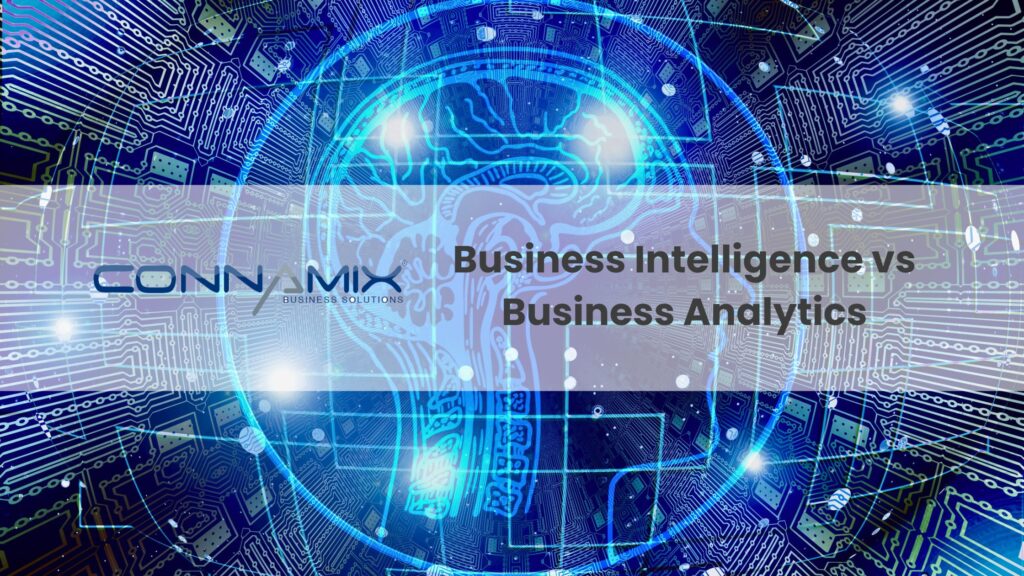Understanding the data behind your business is the key to unlocking future success. Day in, day out, every aspect of your business is generating numbers, statistics and figures and trends, that can all be used to make informed decisions about the direction you’re headed. But how do you decode the data? With Business Intelligence and Business Analytics – that’s how. Let’s break down what these processes entail, how they differ from each other and what role Microsoft Power BI plays.
What is Business Intelligence?
Business Intelligence (BI) refers to the technologies, strategies and practices used by businesses to analyse and transform raw data into meaningful insights and actionable information. Collect, organise and analyse data from various sources within your business, in addition to external sources, to gain a comprehensive understanding of your business’s performance, market trends, customer behaviour and more.
The main focus of BI is to support decision-making processes at all levels within your business. By utilising BI tools and methodologies, you’ll access and interpret data in a way that facilitates informed decision-making, strategising and performance optimisation. Examples of BI practices include data warehousing, integration, modelling, visualisation and more.
What is Business Analytics?
Business Analytics (BA) refers to the practice of utilising advanced analytical techniques, statistical models, data mining and machine learning algorithms to extract meaningful insights from data. It involves the systematic exploration and examination of data to uncover patterns, correlations, trends, and relationships that can be used to drive informed decision-making and improve business performance.
The primary goal of business analytics is to leverage data-driven insights to understand the factors influencing business outcomes. In addition, it will aid you in predicting future trends and outcomes, as well as prescribe actions to optimise business processes and strategies. BA goes beyond descriptive analysis (which focuses on what happened) by incorporating predictive analysis (which focuses on what will happen) and prescriptive analysis (which focuses on what actions to take).
What’s the difference between Business Intelligence and Business Analytics?
Business Intelligence and Business Analytics are similar in nature since both deal with deep diving into the data your business creates through day-to-day activity. However, they differ in three key aspects.
Focus
- Business intelligence: BI primarily focuses on providing a comprehensive view of historical and current data. It aims to summarise and present data in a way that facilitates understanding and decision-making.
- Business analytics: BA focuses on leveraging data to gain insights into future outcomes. It employs advanced analytical techniques to identify patterns, trends, and relationships in data and make predictions or recommendations based on that analysis.
Objectives
- Business intelligence: The main objective of BI is to provide a holistic understanding of business performance, operations, and trends. It helps organisations monitor key metrics, identify strengths and weaknesses, and make data-driven decisions based on historical and current data.
- Business analytics: BA aims to predict future outcomes and prescribe actions to optimize business processes and strategies. It goes beyond describing what has happened and focuses on understanding why it happened and what is likely to happen in the future.
Questions Answered
- Business intelligence: BI answers the questions “what” and “how.” It provides descriptive analytics, answering queries about what has happened and how processes and operations are performing. BI helps identify trends, monitor performance metrics, and provide insights into historical and current data.
- Business analytics: BA answers the question “why” and focuses on predictive and prescriptive analytics. It explores why specific outcomes occurred and utilises statistical models and machine learning algorithms to predict future trends and outcomes and prescribe optimal actions to achieve desired results.
CONNAMIX & Microsoft Power BI
With Microsoft Power BI, Connamix can help you to take your business intelligence to a new level. Effortlessly generate and customize data reports and dashboards, securely sharing them across applications to gain fresh perspectives and delve into deeper insights. What makes Power BI an industry-leading tool is not just the power behind it, but it’s ease-of-use: using applications you’re already familiar with including Microsoft Excel, you can easily build, analyse and present insights.
Speak to us today about stepping up your business’ intelligence and analytics – head to our contact page now.

